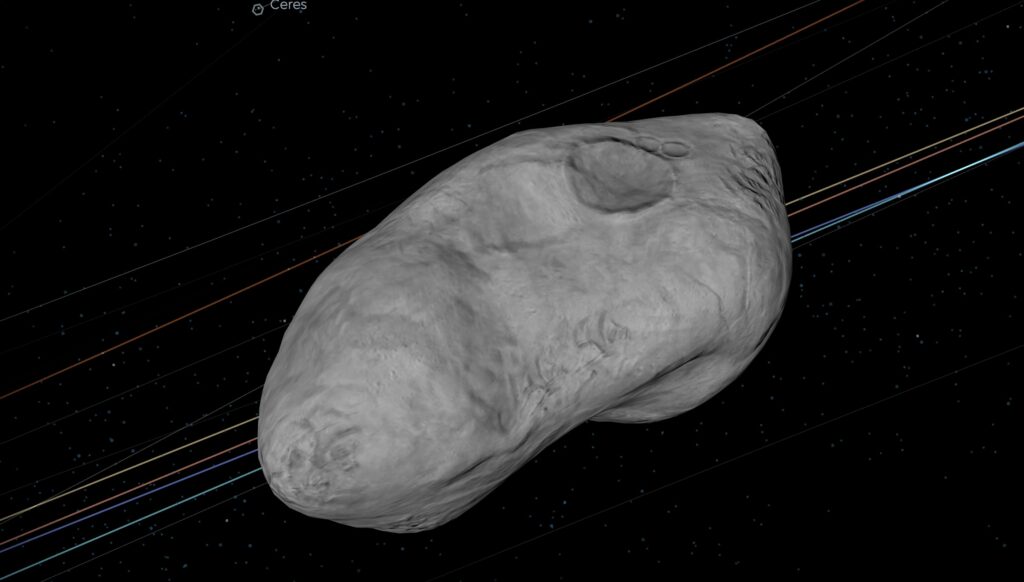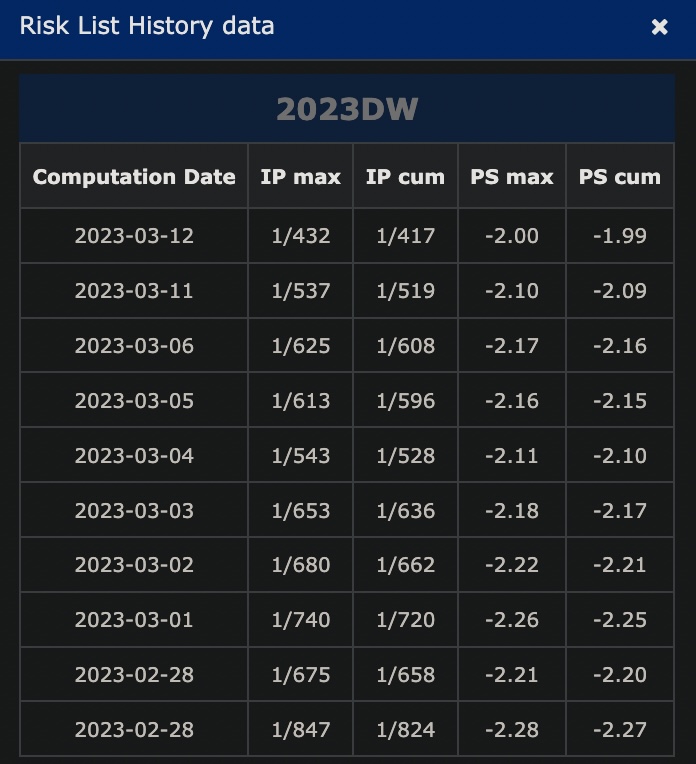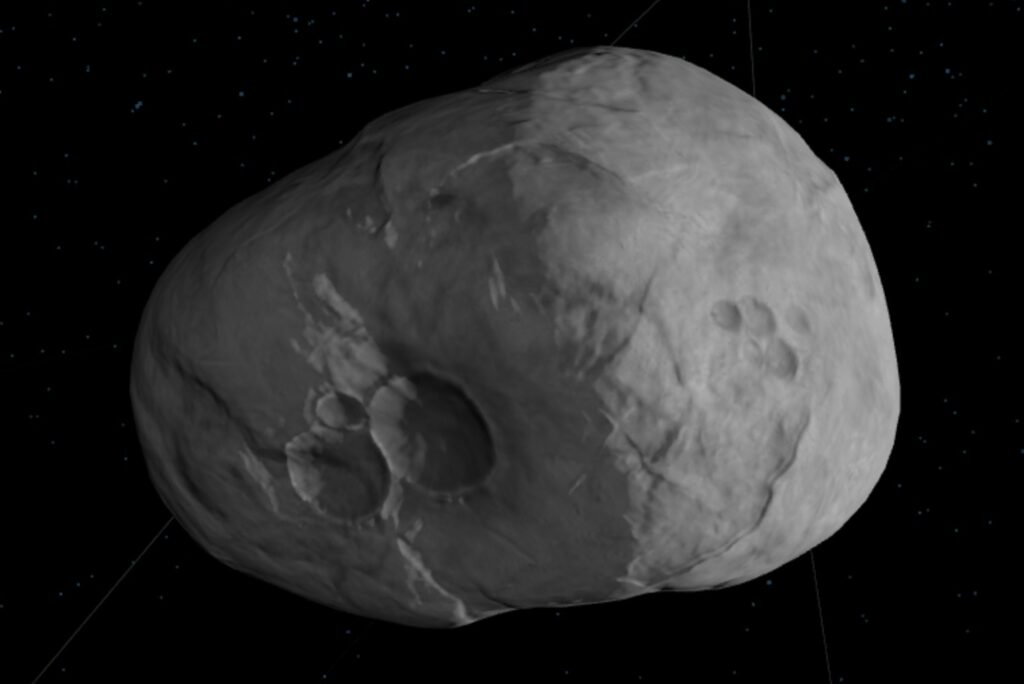Did you have an asteroid hitting the Earth on Valentine’s Day on your apocalyptic bingo card? Well, NASA and the ESA do. The two space agencies keep increasing the odds that Asteroid 2023 DW could hit the Earth. Here’s what the latest updates are telling us.
Originally 1 in 1,200, the Chance Is Now 1 in 360
The asteroid could be on a collision course with Earth on Valentine’s Day 2046. Sure, that’s 23 years away. But it’s close enough that many people reading this article will still be around when it happens.
Although the ultimate chance of hitting the earth is still small, it does keep going up.
We've been tracking a new asteroid named 2023 DW that has a very small chance of impacting Earth in 2046. Often when new objects are first discovered, it takes several weeks of data to reduce the uncertainties and adequately predict their orbits years into the future. (1/2) pic.twitter.com/SaLC0AUSdP
— NASA Asteroid Watch (@AsteroidWatch) March 7, 2023
The asteroid was first discovered in February, and NASA tweeted about the discovery in early March.
They wrote: “We’ve been tracking a new asteroid named 2023 DW that has a very small chance of impacting Earth in 2046. Often when new objects are first discovered, it takes several weeks of data to reduce the uncertainties and adequately predict their orbits years into the future… Orbit analysts will continue to monitor asteroid 2023 DW and update predictions as more data comes in.”
According to NASA’s asteroid tracker, the agency currently estimates that the asteroid is 50.3 meters in diameter.
It will make a close approach of less than .05 AU on February 14, 2046.
As BNO News pointed out, the models keep increasing the chance of the asteroid hitting the earth.
NASA says the chance an asteroid will hit Earth on Valentine's Day 2046 remains small but new models puts the chance at 1 in 360, up from 1 in 560 a week ago and 1 in 1,200 on March 1
— BNO News Live (@BNODesk) March 13, 2023
On March 1, models predicted a 1 in 1,200 chance. Then it was 1 in 560. But now it’s 1 in 360 according to NASA. (Yesterday on March 12, ESA had the estimate at a more comfortable 1 in 625, Science Alert reported. That would be 0.16 percent.)
Two Scales Show an Increasing But Still Small Risk

NPR reported that there are two scales that are used to rank the possible hazard potential of an asteroid. One is the Torino Scale and one is the Palermo Scale — a newer scale.
Where 2023 DW Ranks on the Palermo Scale
In terms of the Palermo Scale, NASA notes: “Actual scale values less than -2 reflect events for which there are no likely consequences, while Palermo Scale values between -2 and 0 indicate situations that merit careful monitoring. Potential impacts with positive Palermo Scale values will generally indicate situations that merit some level of concern.”
So keep in mind that as the Palermo number approaches 0, that means the risk is increasing (albeit it’s still small.)
The scale compares the chance of a potential impact with the “background risk” or average risk of objects of that same size or larger over the years.
NASA notes that a -2 ranking “indicates that the detected potential impact event is only 1% as likely as a random background event occurring in the intervening years.”
You can see the Palermo scale risks on ESA’s website here under the PS max row. 2023 DW sits at -2.00 as of the time of this article’s publication for PS max, and -1.99 for PS cumulative. Only three objects are greater than -3 on the scale, and 2023DW is the greatest of the bunch. (This same chart also lists the Torino Scale number as TS.)
As you can see from the History Data, the risk has been ever-so-slightly increasing since the object was discovered, growing from -2.28 on February 28 to -2.00 on March 12.

2023 DW’s Torino Scale Rank
The 2023 DW asteroid is ranked 1 on the Torino Scale (with it needing to reach 3 for even a 1% chance of “localized destruction”), Science Alert noted. NPR reported that a 1 value is a “routine” near-Earth pass that wouldn’t pose an unusual level of danger.
NASA explains the Torino Scale here. 1 is color-coded green and indicates newer observations will “very likely lead to re-assignment to Level 0.”
NASA lists all the current objects being monitored on its Sentry Page here. Everything on that list has a Torino Scale of 0 except 2023 DW, which has a Torino Scale of 1.
It’s worth noting that the asteroid’s size of 50 meters is roughly equivalent to the Tunguska Event asteroid, that caused widespread destruction over about 830 square miles, but not humanity-threatening-apocalyptic destruction. Of course, no two asteroids are alike.
Post Apocalyptic Media will explore the damage potential in more detail in the next article, so please check back in.
Want to chat about all things post-apocalyptic? Join our Discord server here. You can also follow us by email here, on Facebook, or Twitter.

